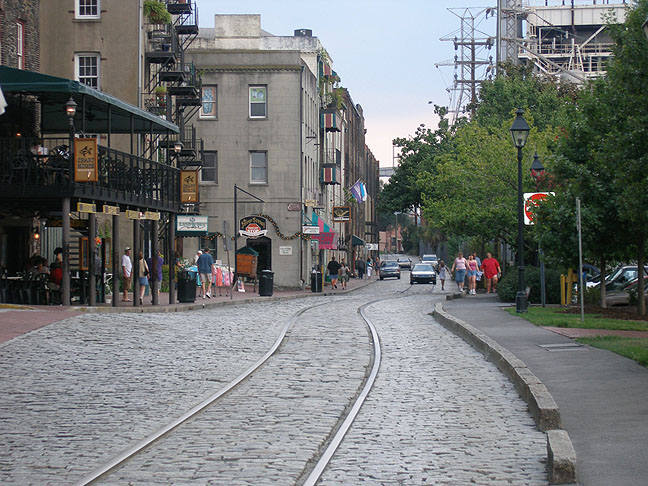 Savannah, Georgia, is showing the way for Jacksonville and plans to open as early as November.
Savannah, Georgia, is showing the way for Jacksonville and plans to open as early as November.
 The Streetcar in the Center of our original Jacksonville Traction Emblem spent it's last years working the transit lines in Savannah. One of the lucky few to survive the fate of chicken coops, sheds and "Florida rooms".
The Streetcar in the Center of our original Jacksonville Traction Emblem spent it's last years working the transit lines in Savannah. One of the lucky few to survive the fate of chicken coops, sheds and "Florida rooms".
River Streetcar: November at earliest
LAUREN NARDELLA
Saturday, August 23, 2008 at 12:30 am
The rails along River Street won't be put to good use for another few months.
The highly anticipated River Streetcar is presently in Altoona, Pa., for electrical and mechanical gear to be put in place.
It's expected to be delivered to Savannah in six to eight weeks, said Sean Brandon, the city's mobility and parking director.
After it undergoes testing, it could be operational as early as November.
"It's been a journey," Brandon said at a streetcar information session Friday. "This is ... one of the most difficult projects we've had to undertake."
The streetcar is from the 1930s and has been completely refurbished as a modern, hybrid vehicle.
"It's a Prius on steroids," said Gary Landrio, assistant vice president of Tran Systems, a transportation consulting company in Warren, Pa.
"(The River Streetcar) is one of the most cutting-edge things from a green standpoint that's being done anywhere in North America," he said. "There's no vehicle like this."
When the streetcar is operational, it will run from noon to 8 p.m. to allow for extra space on River Street for business deliveries in the mornings.
It will hold 50 to 80 people, and round-trip fares will be 50 cents. The free dot shuttle will connect to a streetcar stop at City Hall.
Disability access
Part of the delay in the streetcar's completion stemmed from the addition of two wheelchair lifts.
The technology for the lifts needed to be hidden in order for the streetcar to still look like it's from 1935 - which took up a lot of time, Landrio said.
A significant amount of people with disabilities visit Savannah, according to Brandon. The streetcars will be fully ADA accessible.
"Now somebody with mobility challenges can ride the length of River Street and can get on and off to visit what they want to," Brandon said.
Cynthia Egan, owner of Arts & Crafts Emporium on River Street, is pleased the streetcar will be able to accommodate wheelchairs.
"I think it will bring a lot more tourists that normally couldn't come down here," she said. "It really fills a void."
Moving the rails
The streetcar will use the existing rails along River Street.
But there's a possibility the rails might need to be moved along the stretch from Spanky's restaurant to the Olde Harbour Inn, Brandon said.
The rails shift in that spot, and moving them two to two-and-a-half feet north may make it easier for motor vehicle traffic to move along River Street at the same time as the streetcar.
While a decision won't be made on moving the rails until the streetcar is tested, the city plans to move forward with the assumption that the work will need to be done.
"The goal is to get this in as soon as possible," Brandon said.
The general consensus is that it would be best to move the rails in December (excluding the week of Christmas), January or February to cause the least amount of disruption to businesses.
If everything else works out on schedule for the streetcar, it would operate from the west end of the route up to the construction area.
More delays possible
Another possible hurdle on the way to the streetcar becoming fully operational is the Federal Transit Administration.
The city submitted a safety plan to the administration in July and received a 40-page response Thursday.
The FTA works with a local office in Atlanta, which works with the state Department of Transportation, according to Brandon.
He said they don't have much experience with passenger rail, except for the Metropolitan Atlanta Rapid Transit Authority.
"I hope they don't try to treat us like MARTA," he said, adding that the safety standards should be different and should take into consideration the routes and speeds of the vehicles.
The FTA would need to approve the safety plan before the streetcar could run in Savannah.
The streetcar may eventually have a counterpart on River Street.
Another has been purchased by the city, but it won't be refurbished until the first car and the rails are complete and fully operational.
BLOGGER QUESTION: So Jacksonville, the city that would have been FIRST with a heritage streetcar system. But for Jake Godbold and unfounded fears that it would chase away the UMTA gift of a "free Skyway". Are we now going to drag ourselves last in line?




























